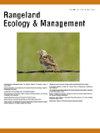Decadal Dynamics of Rangeland Cover Using Remote Sensing and Machine Learning Approach
IF 2.4
3区 环境科学与生态学
Q2 ECOLOGY
引用次数: 0
Abstract
Rangeland degradation in arid and semi-arid regions poses significant environmental and socioeconomic challenges globally. This study aims to assess the Spatio-temporal dynamics of rangeland changes in Khushab district, Pakistan, between 2000 and 2020 by developing an integrated approach combining remote sensing, vegetation indices, and machine learning techniques. The specific objectives were to: (1) quantify rangeland extent changes using multi-temporal Landsat imagery, (2) evaluate rangeland health through multiple vegetation indices, and (3) analyze the primary drivers of rangeland transformation. The methodology integrated Landsat-derived land use land cover (LULC) classification using Random Forest and SMILE CART algorithms, analysis of six vegetation indices (NDVI, GNDVI, SAVI, EVI, ARVI), and land surface temperature (LST) assessment. The classification accuracy exceeded 90% for Random Forest and 87% for SMILE CART across all time periods. Results revealed significant rangeland degradation, with area declining from 9% to 6% of total land between 2000 and 2020. Cropland expansion was the primary driver, increasing from 16% to 29% and converting 218 sq km of rangeland. Vegetation indices showed stable NDVI but declining GNDVI maximums from 0.37 to 0.36, indicating deteriorating plant health. Rising minimum LST from 27.82°C to 31.81°C suggested increasing heat stress on vegetation. This research demonstrates the effectiveness of integrating multiple remote sensing approaches with machine learning for comprehensive rangeland monitoring. The findings provide crucial baseline data for evidence-based policy making and sustainable rangeland management in Pakistan's semi-arid regions. Future work should incorporate ground validation and socioeconomic surveys to better understand degradation drivers and develop targeted conservation strategies.
基于遥感和机器学习方法的草地覆盖年代际动态研究
干旱和半干旱地区的牧场退化给全球带来了重大的环境和社会经济挑战。本研究旨在通过开发一种结合遥感、植被指数和机器学习技术的综合方法,评估2000 - 2020年巴基斯坦Khushab地区草地变化的时空动态。具体目标是:(1)利用多时相Landsat图像量化牧场范围变化;(2)通过多种植被指数评估牧场健康状况;(3)分析牧场转变的主要驱动因素。该方法综合了基于随机森林和SMILE CART算法的landsat土地利用土地覆盖(LULC)分类、NDVI、GNDVI、SAVI、EVI、ARVI等6个植被指数分析和地表温度(LST)评估。在所有时间段,Random Forest的分类准确率超过90%,SMILE CART的分类准确率超过87%。结果表明,2000年至2020年间,牧场退化明显,占总土地面积的比例从9%下降到6%。耕地扩张是主要驱动力,从16%增加到29%,转化了218平方公里的牧场。植被指数NDVI稳定,GNDVI最大值在0.37 ~ 0.36之间,呈下降趋势,表明植被健康状况恶化。最小地表温度从27.82°C上升到31.81°C,表明植被热胁迫增加。该研究证明了将多种遥感方法与机器学习相结合用于综合牧场监测的有效性。这些发现为巴基斯坦半干旱地区基于证据的政策制定和可持续牧场管理提供了关键的基线数据。未来的工作应结合地面验证和社会经济调查,以更好地了解退化驱动因素并制定有针对性的保护策略。
本文章由计算机程序翻译,如有差异,请以英文原文为准。
求助全文
约1分钟内获得全文
求助全文
来源期刊

Rangeland Ecology & Management
农林科学-环境科学
CiteScore
4.60
自引率
13.00%
发文量
87
审稿时长
12-24 weeks
期刊介绍:
Rangeland Ecology & Management publishes all topics-including ecology, management, socioeconomic and policy-pertaining to global rangelands. The journal''s mission is to inform academics, ecosystem managers and policy makers of science-based information to promote sound rangeland stewardship. Author submissions are published in five manuscript categories: original research papers, high-profile forum topics, concept syntheses, as well as research and technical notes.
Rangelands represent approximately 50% of the Earth''s land area and provision multiple ecosystem services for large human populations. This expansive and diverse land area functions as coupled human-ecological systems. Knowledge of both social and biophysical system components and their interactions represent the foundation for informed rangeland stewardship. Rangeland Ecology & Management uniquely integrates information from multiple system components to address current and pending challenges confronting global rangelands.
 求助内容:
求助内容: 应助结果提醒方式:
应助结果提醒方式:


